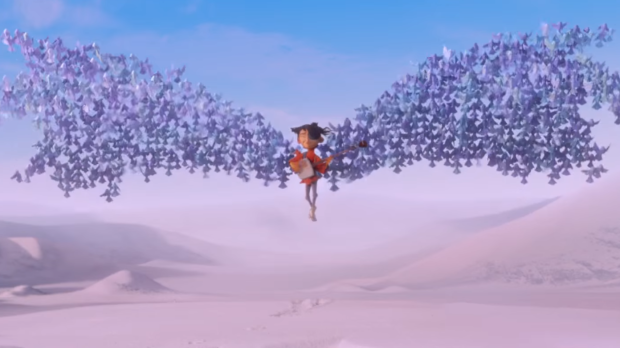Perhaps it’s understandable that Kubo and the Two Strings, Laika’s latest foray into the world of stop-motion animation, has gone mostly overlooked during the summer blockbuster onslaught. Perched uneasily between standard kiddie fare and art-house experimentation, it’s not the kind of animated movie designed to keep kids happy for 90 minutes and then send them out into the world to buy Happy Meals and plush toys. That alone might be enough to recommend it.
Rather than merchandising sales, what Kubo and the Two Strings really wants from its audience is their attention. “If you must blink, do it now,” Kubo (Art Parkinson) insists at the very beginning of the film. It’s an introduction spoken directly to characters within the story, but it’s meant for the movie’s viewers as well.
Each day, Kubo ventures from the mountainside cave in which he lives with his ailing mother, Sariatu (Charlize Theron), to weave tales for the townsfolk in exchange for a few coins. Most of Kubo’s stories, which he illustrates by magically animating tiny origami figures, revolve around the exploits of the legendary samurai, Hanzo. These heroic yarns are popular with the people, but frustrating as well because Kubo never gives them a proper ending.
Little does Kubo’s audience know that the little paper figure of Hanzo is actually based on Kubo’s real father, a great warrior who disappeared years earlier while battling Kubo’s maternal grandfather, the Moon King (Ralph Fiennes). This mystical menace had already torn out one of the infant Kubo’s eyes (remember, we’re not in Disney territory here), but before the fiend could claim the other, Hanzo sacrificed himself so that Sariatu would have enough time to escape with the child. Now Kubo and Sariatu live alone in their cave, unable to come out at night lest Sariatu’s vicious sisters (both played by Rooney Mara) arrive to finish the job the Moon King started.
Of course, they are discovered after Kubo loses track of time while participating in a religious ceremony that he hopes will allow him to commune with his dead father. When the sisters attack, Sariatu expends the last of her magic to transport Kobu to safety, leaving him in the care of an irritable talking monkey she has conjured from a charm Kubo kept in his pocket. Rather than remain hidden, Kubo convinces Monkey (also Charlize Theron) to help him search for a legendary set of armor, the location of which is somehow known to the now sentient little origami Hanzo. Along the way, the travelers also enlist the aid of Beetle (Matthew McConaughey), a one-time samurai cursed by the Moon King to live in insect form.
The adventures which follow do their best to earn the film’s admonition not to blink. An aerial assault against a giant skeleton and an eerie underwater encounter are both undeniable treats for the eyes, ones made all the more impressive by the fact that a good portion of what is on the screen has been hand-sculpted and meticulously animated frame-by-frame. It also helps immensely that Laika has chosen to go with visually appealing characters this time around rather than repeat the butt-ugly designs of their previous feature, TheBoxtrolls.
Along with its visual artistry, Kubo and the Two Strings also aspires to a somewhat deeper narrative than the typical animated feature. There is a palpable sense of melancholy running throughout the film, particularly in early scenes in which Kobo cares for his weakened mother and the villagers prepare to honor their dead ancestors. There is also much talk of an afterlife (which, given the setting, has an understandably Eastern flavor to it) and not all of the characters make it to the end of the story. Amidst all the fantastical trappings, there is a valiant effort to address real life concerns, albeit in a way that doesn’t go over the heads of children.
Unfortunately, much like their main character, Laika has some trouble coming up with a proper ending for their story. Hoping to sidestep the Disney trope of offing the villain in the final reel, the filmmakers have attempted to fashion a pathway to conversion for their antagonist. The problem is that conversion requires choice, and the Moon King is given none. It’s a false note that robs the film of a lot of its potential impact. Still, even with this one big misstep, Kubo and the Two Strings is an artistic triumph. And though its sometimes somber time means your kids might not laugh as much as they do at some other animated features, at least they won’t be bugging you to buy Kubo stuff the second they leave the theater.

